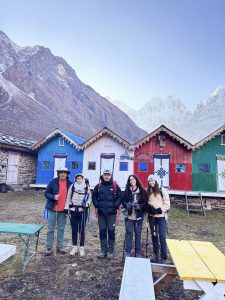Discovering the untamed beauty of the eastern Himalayas of Nepal, one of the most adventurous trek the king of “off- the beaten trekking route” in the Nepali Himalayas, Kanchenjunga Trek. This exhilarating Himalayan endeavor leads to an awe-inspiring trekking journey for those who are fanatic trekkers seeking a peace and placid experience, far from hustle and bustle of other famous trekking routes. Kanchenjunga Trek is about exploring a remote and an isolated part of Nepal, followed by unspoiled wilderness and trails. It is about preceding your journey towards the third highest peak in the world, Mt. Kanchenjunga which is 8,586 meters. To experience the picturesque view of wilderness and captivating aroma of rusticity and to understand the magnificence of the eastern Himalaya. To experience these all, you have to know about the best time for Kanchenjunga Trek?
You must be very much curious to know about the appropriate time to do this Trek, if you are considering for this trek. So, we are here to make your journey more thrilling and providing the best timeframe for Kanchenjunga Trek. In general, it depends on what kind of experience you want to have. Two seasons are considered as the best seasons for exploring Himalayas which falls on spring (March- May) and autumn (September- November). Even though summer and winter are considered as off-seasons for trekking still, it is possible with proper preparations and equipment. So, to know the best time and itinerary for Kanchenjunga Trek please check below in details.

Best Time and Brief Details about Different Seasons
The trekking in Nepal are all- seasonal adventures exploring diverse experiences in different seasons. However, you are delving in the trails of third highest peak in the world with its significant altitudes between 4,000- 5,000 meters; you must have to consider the seasons carefully. Unlike other low- altitude journeys which are feasible whole year, this high- altitude trekking route might be slightly challenging and physically demanding during off- seasons.
Though, each season has its own idiomatic touches to glorify the beauty of Himalayan grandeur of Kanchenjunga Trek. Here are brief details about different seasons and adventures that you explore while choosing the particular season.
Spring- The Peak season (March, April and May)
There is no doubt that, the spring is one of the peak, best and considered as the crown bearer among all other seasons. It is the peak for trekking season in Nepal which is ideal time for Kanchenjunga Trek offering a perfect blend of beautiful nature, stable weather and the vibrant flora with fauna. The season of rhododendron which makes forest alive with the vivid light of its blossoms. The color of rhododendron makes forest and the trail of this trek alive, it spreads its fragrances making the pathway of Himalayas magical and exhilarating. The trekkers can walk under canopies of red, pink, and white blossoms, with the gentle hum of nature all around. Wildlife during this season is also more active, offering chances to spot Himalayans birds and the red panda. Trekking in spring makes you feel like majestic as you come across the lush of greenery and eyes catching views of vibrant colors all around.
The visibility during this season is excellent, with clear blue skies and mesmerizing views of mountains, especially in the morning. You can see incredible views of towering peaks like Kanchenjunga, Janu and Yalung Kang mountains, often capped with fresh and white lightening snow from winter, as this season starts right after winter. The weather in this season is stable and also temperatures are moderate and comfortable. Average temperature in this region is around 17°C in day time, rising up to 25°C and can drooping up to -15° C at higher elevations. This makes trekking experiences more enjoyable.
Autumn–The stable season (September, October, and November)
Autumn is considered as the most suitable season for Nepal trip. The season which has most stable climatic conditions. It is also an another best time to explore Kanchenjunga Trek. This season comes right after the monsoon, so the air, environment and trails are fresh, captivating and dust free. The precipitation rate in this season is very low, providing you the absolute visibility of beautiful Himalayas trek. The trails are drier and safer in this season and river levels are normal, which makes easier to cross suspension bridges.
Autumn is also the season of festivals and golden harvestings. Though the wilderness does not shine as brighter as spring does, this is the season where nature takes a break. The greenery slowly turns in grey, yellow, brown and crimson making mountains shine brighter than anything else. This provides amazing opportunities to enjoy the breath-taking scenery of mountains. Though the wilderness does not boom much in this season but the culture of Nepal does. This is regarded as the hub of diverse cultural experiences in Nepal as well as in Kanchenjunga. Festivals like Dashain and Tihar falls in this season, which gives you an opportunity to explore different rites and rituals practices during these festivals. Though the temperate is fluctuating, the average temperature of this season in Kanchenjunga region is around 15° C, rising it up to 20° and dropping as low as -10° C in the alpine zones an in night and in morning.
Off-Seasons- Exploring Kanchenjunga during Monsoon and winter
Monsoon and winter are considered as off seasons compared to other season for trekking in due to vulnerable seasons. As in winter the temperatures are extremely cold in higher altitude making trekking difficult and challenging and during monsoon there is high rainfall making trails risky and dangerous. Hence, spring and autumn seasons are regarded as the best and peak seasons for trekking in Nepal this does not mean that trek cannot be explored during the off seasons.
With proper planning, guidance and equipment you can explore this trails even in off-seasons as well.
Monsoon Season (June, July and August)
The season which is the most notable off-season for trekking adventures in Nepal. The season with frequent rains and storms cause high risk of landslide in trails. Heavy rain falls makes trails slippery, muddy and there is high risk of parasites like mosquitoes and leeches. Due to these your itinerary might not work as scheduled.
To overcome this challenges, you can explore Kanchenjunga trek with right gear and waterproof layers, there are forest covered with lush of green grasses all around. The water levels get its life back making rivers, streams, ponds and waterfalls sing their song. This adds glory in the environment and makes it more exciting and thrilling.
Winter Season (December, January and February)
This season might be more challenging and demanding endeavor. The temperatures of trekking destinations can drop drastically below freezing point. During this season the alpine zone of Kanchenjunga which is between 4,000- 5,000 are generally covered with snow. Heavy snowfalls may block trekking trails and you may not get teahouses and lodges due to harsh weather conditions. So there will be very high chances that itinerary might not work here during this season. Apart from this the experienced trekkers with proper gear can explore this treks during winter but it will be difficult for beginners.
So, we humbly recommend you to choose the best season according to your preferences to explore the mesmerizing views of third highest peak in the world The Kanchenjunga. We are here to give you the best guidance about the trek and trails that you are considering for your holidays. To lead you to the eastern part Nepal exploring diverse cultures and landscapes. We are here for you to make your journey remarkable.

